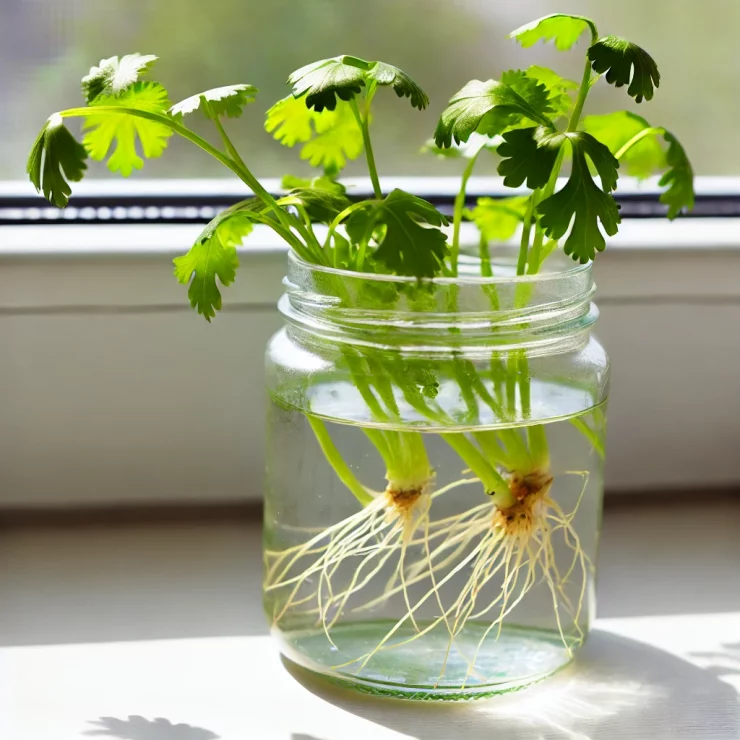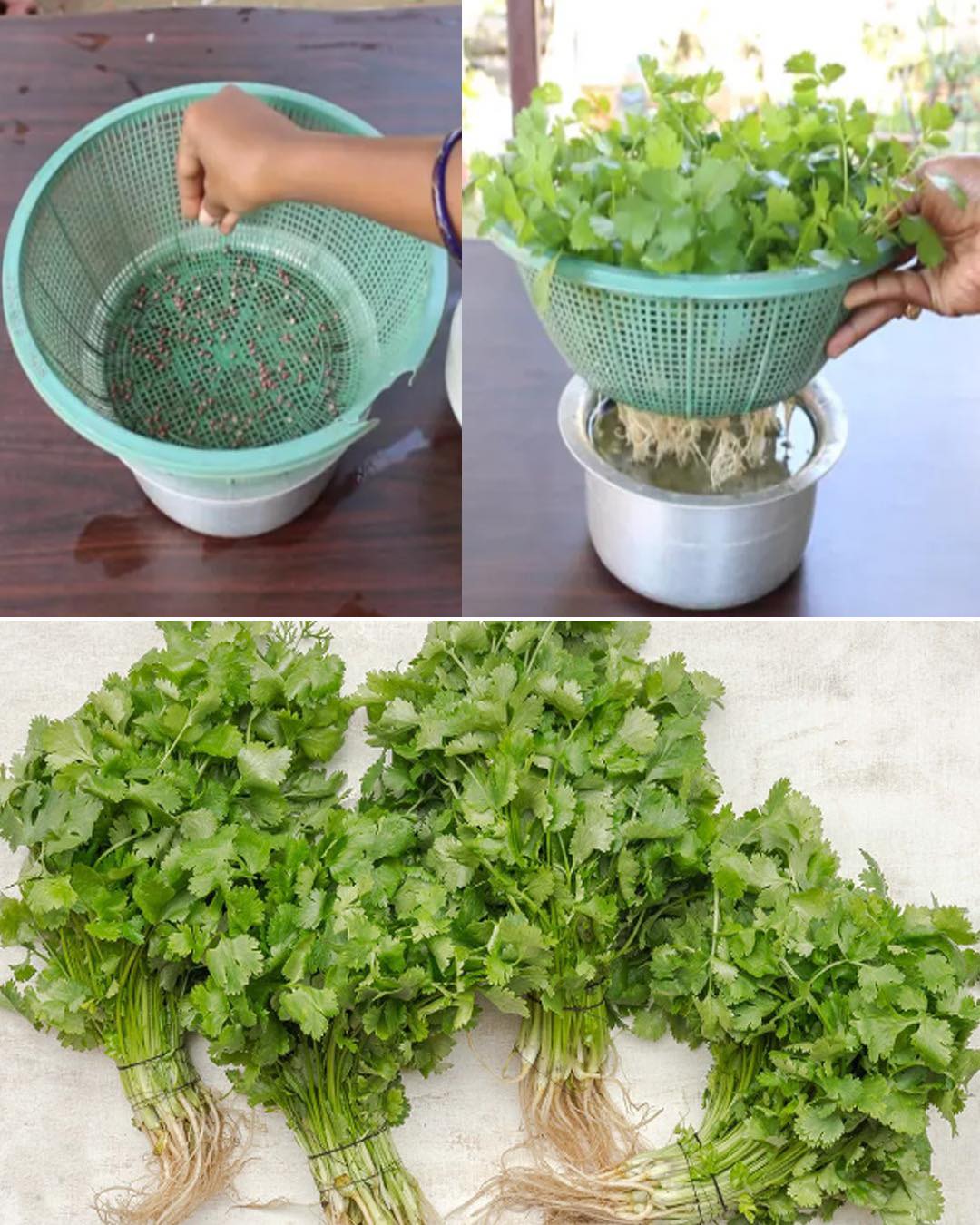Coriander, also known as cilantro, is a versatile herb used in various cuisines around the world. While it’s commonly grown in soil, did you know that you can easily grow coriander at home in water? This method is not only space-efficient but also incredibly convenient, especially for those who don’t have a garden or prefer a mess-free growing process. Here’s a step-by-step guide on how to grow coriander at home in water.

1.Gather Your Supplies
Before you start, you’ll need a few basic supplies to grow coriander in water. Here’s what you’ll need:
Fresh coriander cuttings (with roots if possible)
A glass or jar
Clean, chlorine-free water
Scissors or a knife
A sunny windowsill
2.Prepare the Coriander Cuttings
The first step is to prepare the coriander cuttings. If you’re starting with fresh coriander from the store, choose a bunch with healthy, green stems. If possible, select cuttings that still have the roots attached, as this will make the growing process faster and more successful.
Steps:
Cut the Stems: Using scissors or a knife, cut the stems of the coriander about 4-6 inches long. If the roots are intact, keep them as they will help the plant grow more effectively.
Remove Lower Leaves: Strip off the leaves from the lower part of the stems, leaving the top few leaves intact. This prevents the leaves from rotting in the water.
3.Place the Cuttings in Water
Now that your coriander cuttings are prepared, it’s time to place them in water.
Steps:
Fill the Glass or Jar: Fill your glass or jar with clean, room-temperature water. Make sure the water is chlorine-free, as chlorine can hinder root development. If you’re using tap water, let it sit out for 24 hours to allow the chlorine to evaporate.
Submerge the Stems: Place the coriander stems in the water, ensuring that the lower part of the stems is submerged. The top leaves should remain above the waterline.
Position: Place the glass or jar on a sunny windowsill where the cuttings can receive plenty of natural light.
4.Change the Water Regularly
To keep your coriander healthy and encourage root growth, it’s important to change the water regularly.
Steps:
Change Water Every 2-3 Days: Empty the old water and refill the glass or jar with fresh, clean water every 2-3 days. This prevents the water from becoming stagnant and reduces the risk of bacterial growth.
Check for Root Growth: After about a week, you should start to see roots developing from the base of the stems. Continue to change the water regularly to keep the cuttings healthy.
5.Provide Adequate Light
Coriander needs plenty of sunlight to thrive. Place your jar or glass in a spot where it can receive at least 6-8 hours of sunlight each day.
Tips:
Rotate the Jar: Rotate the jar every few days to ensure all sides of the plant receive equal sunlight.
Supplement with Grow Lights: If you don’t have a sunny windowsill, consider using a grow light to provide the necessary light for your coriander.
6.Harvesting Your Coriander
One of the great benefits of growing coriander in water is that it’s a continuous source of fresh herbs. Once the plant has developed strong roots and new leaves have started to grow, you can begin harvesting.
Steps:
Trim the Leaves: Use scissors to trim the leaves as needed for cooking. Harvest from the top of the plant to encourage bushier growth.
Regular Harvesting: Regularly harvesting the leaves will prevent the plant from becoming leggy and encourage it to produce more foliage.

7.Maintaining Your Water-Grown Coriander
To keep your coriander thriving, follow these maintenance tips:
Tips:
Keep the Water Level Consistent: Ensure the water level in the jar remains consistent. Add more water as needed to keep the stems submerged.
Monitor for Pests: Although less likely, keep an eye out for any pests that may appear on the plant. If you notice any, remove them promptly.
8.Transitioning to Soil (Optional)
If you eventually want to transfer your coriander to soil, you can do so once the roots are well-established. This will allow the plant to grow more robustly and produce a larger yield.
Steps:
Choose a Pot: Select a pot with good drainage and fill it with a nutrient-rich potting mix.
Transplant: Carefully remove the coriander from the water, being mindful of the delicate roots, and plant it in the soil. Water the plant well after transplanting.
Continue Care: Place the pot in a sunny spot and continue to water and care for the plant as it grows.
Growing coriander at home in water is a simple and effective way to have a continuous supply of fresh herbs right at your fingertips. With just a few cuttings and a bit of care, you can enjoy the aromatic flavor of coriander in your cooking, all year round. Whether you choose to keep your coriander in water or eventually transplant it to soil, this method is perfect for anyone looking to start a small herb garden indoors.
News
JJ Redick reacts to Luka Doncic trade for Anthony Davis
In one of the most jaw-dropping moves of the season, the NBA landscape was rocked by the blockbuster trade involving Luka Dončić and Anthony Davis—a swap that has sent ripples of excitement, disbelief, and heated discussion through the league. Among…
Anthony Davis FULL reaction to trade to Mavericks for Luka Doncic
In a blockbuster move that sent shockwaves through the NBA and left fans reeling, Anthony Davis has been traded to the Dallas Mavericks in exchange for Luka Dončić. In the immediate aftermath of the news, Davis took to the media…
Shaq reacts to Dallas Mavericks wanting Kevin Durant after Luka-AD trade 👀
In the constantly shifting world of the NBA, trade rumors and blockbuster moves are a regular part of the season’s drama. The latest twist has fans buzzing: the Dallas Mavericks have reportedly set their sights on acquiring Kevin Durant in…
Donovan Mitchell FILTHY poster dunk on Kristaps Porzingis 😳
In a game filled with high-intensity moments and jaw-dropping highlights, one play in particular has left fans and analysts buzzing about Donovan Mitchell’s latest display of athleticism. Early in the contest, with the atmosphere already charged by an evenly matched…
Joel Embiid hits go-ahead bucket vs Mavs then chats with Anthony Davis after game
In one of the most thrilling contests of the season, Joel Embiid delivered a clutch performance against the Dallas Mavericks, punctuating the game with a go-ahead bucket that sent the home crowd into a frenzy. The atmosphere in the arena…
D’Angelo Russell game winner as Nets hit two 3’s in 3 seconds to win vs Rockets 😱
In one of the most electrifying moments in recent NBA history, D’Angelo Russell delivered an unforgettable game-winner that left fans and commentators in complete awe. With the Brooklyn Nets locked in a tense battle against the Houston Rockets, the outcome…
End of content
No more pages to load











